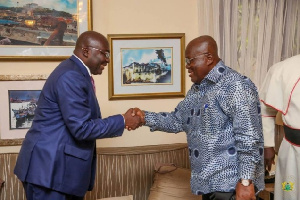Opinions of Tuesday, 19 July 2022
Columnist: Senyo Sosu & Michaela Chetty
Curriculum is useless when government cannot provide resources
From my perspective as a teacher and a philanthropist, effective teaching in primary schools is a major concern in many countries of the world. For effective teaching to take place, teachers who distinguish themselves and devote themselves to learners, need to be resourced to make the curriculum useful.
It is argued that effective teaching also takes place where there is reflective practice (Nolan and Hoover, 2008; Delvin, Kift & Nelson, 2012). You can only practice if you have the needed resources obtainable to you (Molapo & Pillay, 2018). On the other hand, some people believe that effective teaching takes place if teachers have been exposed to in-service training.
I totally agree with Michaela Chetty from South Africa, that Curriculum is useless when governments cannot provide resources. This write-up looks to explore why curriculums are ineffective due to the lack of resources and incentives for those going to carry out the contents of the curriculum.
Success is judged by the final result of a project and so without Teaching and Learning Resources, the curriculum can be difficult to implement. Teaching-learning resources assist in and support student learning.
These resources are able to do this by practically equipping the learners with a basic understanding of content, which the learners can utilize when applying their higher-order thinking skills. This is essential as it highlights elements from Bloom’s taxonomy which is an integral part of the classroom.
This allows students to understand and enjoy the lesson that the teacher teaches them. It helps students understand the objective of the lesson the teacher is conveying.
In the classroom, when using curriculum-based assessment, the final result runs the risk of being ignored. The evaluators are assessing the work of the teacher based on their ability to plan in advance based on the resources available. The curriculum is a material assembled based on the teacher's belief of how the class should be conducted.
In the end, a curriculum does not define what a student learns -- the teacher's interaction with the students themselves determines the students’ success in learning the material.
So, in this regard when the teacher is not resourced then improvising becomes the next available option which is very difficult sometimes to do, and which I have experienced so many times in the classroom as teacher. Don’t get me wrong, most of the work is much more theory based and thus the curriculum is basically not effective.
The teacher, like the artist, the philosopher and the man of letters, can only perform his work adequately if he feels himself to be an individual directed by an inner creative impulse, not dominated and fettered by an outside authority.
Bertrand Russell, Unpopular Essays (1950:159), as a teacher, the inner creative impulse can only be gratified by incentives which will be and of cause is the stimulating factor to get ready with the chalk or the marker.
My first teaching appointment: I was posted to a very hard to reach area called Dawia in the Ashanti Region of Ghana, without potable drinking water, no access to electricity, no road: the only highway to the village is a foot path which I trek on for many miles to get to school.
No access to mobile network which made it very difficult at times to connect to the district office and so our school was completely cut off from the rest of Ghana. You can imagine how difficult it will be pulling teaching and learning resources to the village for the school even if the government should provide them.
But the only thing that could push me to go to the village to teach was the availability of teachers’ bungalows provided close to the school by a nonprofit organization and so when teachers are incentivized in any little way or more, that could make curriculum significant and its implementation successful. But for the timely intervention of an NGO or nonprofit organization, my enthusiasm to teach could have dwindled.
Government alone as we know cannot provide all teaching-learning resources, bodies like, non-governmental organizations (NGOs) can also contribute their quota.
I have benefited from nonprofit organizations as a teacher and now that I am privileged to be the CEO of the Fafali Organization, a nonprofit organization in Ghana, my focus has mainly been on how to resource underprivileged children and schools as a way to support the government.
Resources by the government will produce measurable outcomes using the curriculum, but where the strength of government is not enough, an enabling environment should be created for nonprofits or NGOs to help in that regard. Michaela Chetty, from the University of Stellenbosch, South Africa, training to become a professional teacher.
Michaela came to Ghana, to participate in a summer study program with the University of Ghana and volunteered with Fafali Organization in some of our public schools, and made these observations………….

My time observing in Ghanaian schools taught me more than I thought imaginable. The exuberance that the teachers exhibited as well as the vivacious engagement from the learners inspired me for my own teaching practice. However, among the pearls of knowledge that I gained – it struck me that curriculum is limited in its effectiveness.
I deduced a major contributor to these schools in the country not being equipped with the abundant and appropriate resources in order to bring about effective teaching and learning.
I find that the provision of resources to teachers reduces the burden on them. The effort that teachers would have originally placed into teaching learners without resources, can now be redirected. For example; it can be rerouted to higher order thinking skills, and classroom management as well as to give them the opportunity to focus on learners’ holistic development. These features are integral in order to bringing about quality teaching and learning (Jeevanantham, 2008).
Thus, it is seen, that curriculum implementation can only go so far in achieving the holistic aims that the curriculum outlines when there are no resources provided to schools.
Hence, the lack of resources perpetuates rote learning within the classroom. I’ve seen this become a by-product of a lack of resources – teachers are not able to impart higher order thinking (according to Bloom’s Taxonomy) since the learners are unable to internalize and remember basic subject content.
Educational resources assist teachers by providing concepts that are engaged in an easy-to-interpret structure. When there is a lack of resources in the classroom, I have also noted that the lesson becomes teacher-centered.
Since the teacher now has to become the sole disseminator of knowledge. Instead of the knowledge being shared by the use of resources and learners being able to divulge knowledge by themselves. And studies have found that this teacher-centered approach is not advantageous to modern-day teaching practices in the 21st century (Allais, 2019).
Resource provision in African countries is no longer enough, there needs to be contextually relevant literature for the learners to use. This makes knowledge transmission easier for the learners because they can relate to what is being said in the literature firsthand.
While reading a book with two learners, it became apparent that their English proficiency isn’t low but they simply did not have adequate exposure to foreign adjectives or country-specific nouns.
They lack contextual understanding in order to read for enrichment – if resources were given to them that they have a personal connection to, this would reduce the subtle language barrier. Thus, providing an accurate representation of their English reading proficiency.
I thought of a potential, sustainable solution to the lack of government-provided resources. Relationship building with nearby tertiary institutions could be instrumental in providing the resources and mentoring that basic schools need.
An adoption program by tertiary institutions, in order to equip the learners with resources as well as skills. This could also lead to greater access to these institutions for the learners. In addition to this, a possible intervention strategy could be a collaboration between NGOs and businesses in the community.
NGOs could vehemently reach out to local businesses to increase their ‘social responsibility quota’. Business intervention could include – but is not limited to – the sponsoring of resources for the schools.
This collaboration and intervention can be instrumental in the upliftment of schools as well as the positive image of the business being shared to the community (which could be an effective incentivization for businesses).
As educationalists, teachers, and philanthropists, it is essential that we understand the needs of the learners in the classroom and that we are active contributors in helping teachers provide quality teaching and learning despite the lack of resources.
Education is one of the most potent tools that we have for social transformation, which is why it deserves more of our attention.











